Norbiton (5)
By:
January 1, 2021
Anatomy of Norbiton: Archaeological
“But who knows the fate of his bones, or how often he is to be buried? Who hath the oracle of his ashes, or wither they are to be scattered?”
Robert Burton, Hydriotaphia, Sir Thomas Browne
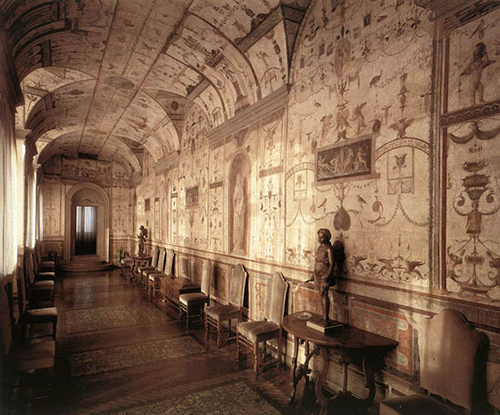
– LOGGETTA OF CARDINAL BIBBIENA,
RAPHAEL
NORBITON: IDEAL CITY has no significant archaeological record. You cannot dig into its fragmentary prehistory of potsherds and burial urns and walls. Similarly, it will leave no physical remnant when it disappears.
Then again, there is no such thing as virgin soil. Nothing emerges wholly untrammelled from the past. Nothing you erect upon the land this minute will not be conditioned by the crushed and compressed litter of dead civilisations that underlie its foundations. You may, for all you know, be walking about on the ruins of cavernous underground cities, Roman baths and temples, silted over in some deluge. You may be about to fall through to the painted caverns of the remote past.
The Ideal City may have no archaeological record, therefore, but it does have an archaeological practice and an archaeological agenda, from the narrow data stream of which we could plot, if it so pleased us, a map of our mental digs, and our suppositional finds, indexed to a variety of objects of the immaterial record.
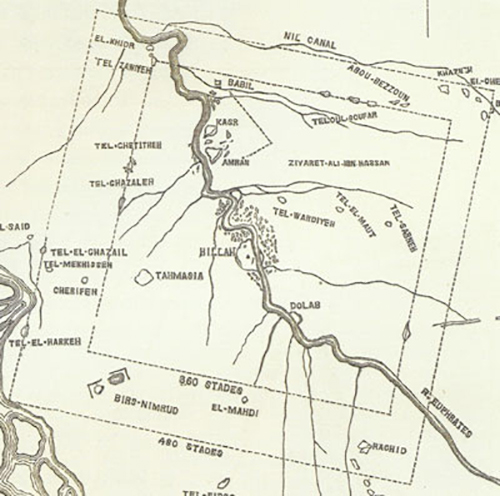
– MAP OF PROPOSED CITY WALLS OF BABYLON,
GEORGE RAWLINSON, 1858
When I was thirteen, my brother persuaded me that our lives would become more elegant if we removed the dust jackets from our books. He thought it would give our not very extensive shelves the feel of a 19th century library. So we did, making a pile of disjecta dust jackets in the middle of the floor, less a bonfire of (very marginal) vanities than a memorial cairn to them.
What did we do next? I don’t remember. Picked them up in armfuls perhaps, and tossed them in the bin. Stuffed them in sacks and marched them over to the dump. It wasn’t exactly the burning of the library at Alexandria, but it was an act that in tiny measure reduced my not-extensive world.
Many second-hand books without jackets have come in on top of the victims of this purge, so it would be impossible for anyone else to trace the line of folly around my shelves. But I can see it anyway, the ghostly shape of the stupidity of my youth, the indelible record of early and irredeemable failure.
“In the regio of the Campus Martius in the time of Julius II [1503-1513], while a certain barber was digging a latrine in the garden of his little house between S. Lorenzo in Lucina and the house of Cardinal Grassi, he discovered the pedestal of the biggest obelisk that has ever been seen in the city. The obelisk had been thrown down, and it was not possible to see whether it was in one piece, since all of it could not be seen… . I learned from the people living in the neighbourhood that every time they excavated the ground for their wine cellars or drains, they had come across various celestial signs, wonderfully designed in bronze, which were in the pavement around the gnomon.”
A. Laelius Podager (after 1521), quoted in The Egyptian Renaissance, Brian Curran, Chicago University Press 2007
Archaeology has come to be associated with digging.
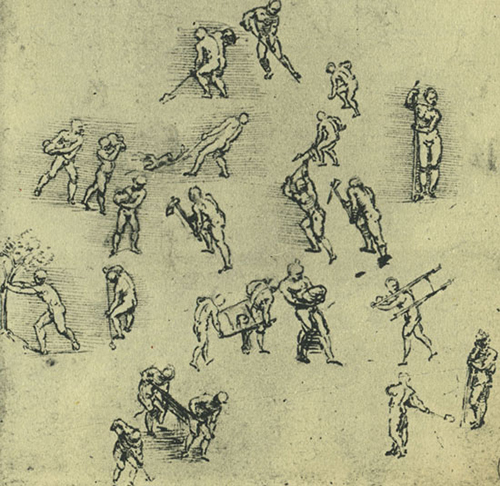
– WORKING FIGURES,
LEONARDO DA VINCI
In the nineteenth century, intellectually rapacious Europeans hired teams of natives who dug for them, scooping out and carting off the sands of Egypt or the rocky soil of Greece and Asia Minor, uncomprehendingly uncovering ancient cities, royal tombs, spectacular treasures.
In the Renaissance, archaeology was more open cast. The ancient world was lying about on the surface—in Rome, mostly—and you did not need to dig, much: just brush the dirt off, pull away the brambles, and there you had it.
So, for example, Niccolò Niccoli and Poggio Bracciolini, two of the great Florentine humanists of the quattrocento, spent time in Rome in the early 1420s piecing together (in their heads) the remnants of the ancient city. This was a question of correlating ancient texts with lapidary evidence and the ruins poking up all over the place. They must have done considerably more musing than digging, but they did clarify the interrelation of these ruins, seeing through the jumble to differences of provenance and age.
Take, for example, the obelisks.
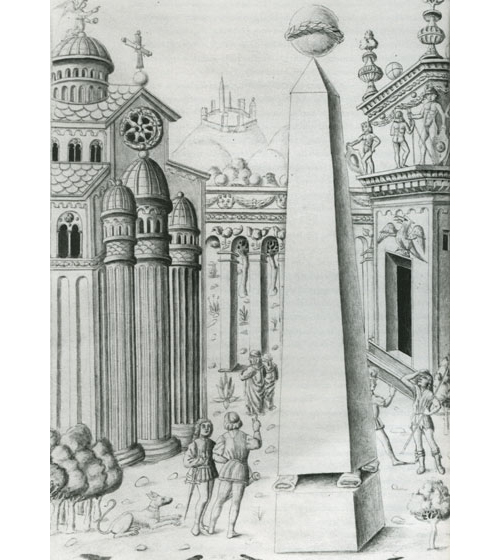
– COLLECTIO ANTIQUITATUM (C.1465-73),
GIOVANNI MARCANOVA
There are eight Egyptian obelisks in Rome. They had been imported by order of various emperors, each eager to adorn his capital with emblems of impossible absurdity. To uproot a hundred-foot, four-hundred-and-fifty ton lump of stone and ship it across the Mediterranean in one piece and then set it up again was a notably preposterous feat of engineering, and Pliny and Ammianus Marcellinus, among others, were keen to detail the process.
By the late middle ages, all but one of these obelisks had fallen down. They lay around broken into bits, their particularity, as with that of the ruins among which they lay, eroded into a sort of garden of mythical stones, each generating its own aetiology and legend. For instance the one standing obelisk—that near the Vatican—was supposed to contain the ashes of Julius Caesar in three brass balls at its summit, and to have been transported into its place by the miraculous intervention of that celebrated magician, Virgil.
The obelisks were just stones now, like any other. That Niccolò Niccoli and Poggio Bracciolini were able to read them accurately was not so much a triumph of philological or archaeological skill as evidence of a quickening need for clarity. Each stone, they reasoned, could be exactly replaced, if not in fact then in imagination. Each stone came from somewhere, was cut for a reason, and that reason could be recovered; in so recovering the provenance and purpose of the sleeping jumble of stones, in sorting and organising them, a measure of sanity could be restored to the modern city, which had just grown on top over the years and squatted there now any old how.
They could construct, in other words, a rational and linear history, and know where along it they stood.
Norbiton, unlike Rome, does not have a rich archaeological heritage. If the deciphering of Rome was a multi-dimensional challenge in which interested parties could hope to decode the ancient city through a cross-referencing of the lapidary, literary and material remains, the deciphering of Norbiton is a simple, if elusive, zero-dimensional challenge, where there are no remains, no written or oral record, no interest, no importance to guide us. We have no funds, no knowledge, no technique. We uncover few celestial signs when we plant our cabbages.
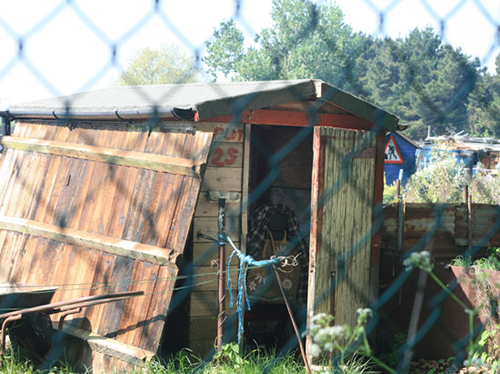
– KINGSTON ROAD ALLOTMENTS
However, while digging over a flowerbed in Kelley’s garden, I do make a modest archaeological discovery. At a point where the soil is especially waterlogged I find, a couple of feet down, a broken old plastic bucket. This is the root of the problem. It stinks of slurry. Poking around it, I start to pull up off-cuts of mottled stone, granite and marble, pieces an inch thick and a few inches long. I wash them off and build a neat little border to the flower bed with them, for my own amusement.
Kelley’s family house is the house of his father-in-law, long dead, who ran the masonry business before Kelley. I surmise idly that the business used to abut the house and its garden, many years ago. Perhaps the garden was the site of the business. Perhaps the whole garden sits atop slagheaps of marble off-cuts, smashed up gravestones and memorial bird tables, granite angel wings and concrete lyres. South London was always London’s graveyard. Or perhaps the father-in-law brought home pretty bits of stone for the amusement of his daughter, or just absently-mindedly in the pocket of his dusty work jacket; perhaps his daughter asked the workmen at the yard if she could keep them when she occasionally visited, perhaps she found them to be pretty, collectible.
I call it an archaeological discovery, but it is nothing of the sort. It is a chance find. Archaeology invokes system and process beyond picking about in a flower bed with a spade. Archaeology is not digging; it is the study of the material culture of the past, or a study of the past through its accidental material remains. A study that (these days) privileges contextual accuracy above narrative interest. Refreshingly so.
Here is a story about Michael Ventris, the man who deciphered Linear B:
Linear B was the name given to an unreadable script first found during excavations at Minos in Crete by Sir Arthur Evans at the end of the nineteenth century. Evans judged it to be Bronze Age, and was convinced for one reason or another that the underlying language was not Greek but particular to an indigenous Cretan culture which he called, with a flourish of moronic inventiveness, Minoan. Evans, in the great tradition of nineteenth century archaeology, had found (founded?) a civilisation.
The script was quietly deciphered in 1952 by Michael Ventris, an amateur philologist and professional architect who had been obsessed with the problem since boyhood. The language was found to be Greek after all. The breakthrough came when he was able to cross-reference similar tablets found at Pylos on Mainland Greece in 1939 by the American Archaeologist Carl Blegen, in which certain groupings of symbols present on the Knossos tablets were absent. Ventris intuited that these might be Cretan place names, and this gave him the necessary key.
Ventris, his life’s work complete, died at the age of thirty-four in a car crash which might have been suicide. He was a lonely, isolated, brilliant young man.
This is what one of his collaborators, the archaeologist John Chadwick, had to say about him:
“If we ask what were the special qualities that made possible his achievement, we can point to his capacity for infinite pains, his powers of concentration, his meticulous accuracy, his beautiful draughtsmanship. All these were necessary; but there was much more that is hard to define. His brain worked with astonishing rapidity, so that he could think out all the implications of a suggestion almost before it was out of your mouth. He had a keen appreciation of the realities of a situation; the Mycenaeans were to him no vague abstractions, but living people whose thoughts he could penetrate. He himself laid stress on the visual approach to the problem; he made himself so familiar with the visual aspect of the texts that large sections were imprinted on his mind simply as visual patterns, long before the decipherment gave them meaning. But a merely photographic memory was not enough, and it was here that his architectural training came to his aid. The architect’s eye sees in a building not a mere facade, a jumble of ornamental and structural features; it looks beneath the appearance and distinguishes the significant parts of the pattern, the structural elements and framework of the building. So too Ventris was able to discern among the bewildering variety of the mysterious signs, patterns and regularities which betrayed the underlying structure. It is this quality, the power of seeing order in apparent confusion, that has marked the work of all great men.”
John Chadwick, The Decipherment of Linear B, CUP 1958
Michael Ventris then: genius, depressive, suicide.
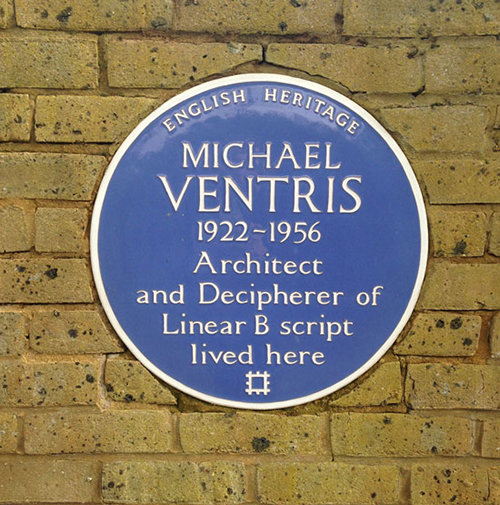
– 19 NORTH END, HAMPSTEAD, LONDON NW3 7HR
PHOTO: BY GARETH E KEGG (OWN WORK) [CC BY-SA 4.0
(HTTP://CREATIVECOMMONS.ORG/LICENSES/BY-SA/4.0)], VIA WIKIMEDIA COMMONS
What is beautiful about the decipherment of Linear B is how meaningless it all turned out to be—and by meaningless I intend something quite specific. Meaning inheres in stories. As stories aggregate, simplify, so meaning swells to grandiose proportion. When Ventris unscrambled the Linear B tablets from Knossos and Pylos it turned out there was in fact no story. Rather what they had in their hands were records of taxation, conscription, and inventories of grain.
As you move in the opposite direction and approach the furthest edges of research, scientific and intellectual endeavour, stories disappear, become irrelevant, falsifying. You are simply in a place, and you potter around in it. The only stories are the speculative frameworks you use to hold it together over a whisky. For your amusement.
What Evans had wanted above all else was a story: a story, I conjecture, to rival those of, among others, but especially, Heinrich Schliemann. This marks him out as a man of a different sort of (potty) ambition.
Ventris, lurking oedipal threat, destroyed that story. There were no stories. Just an accumulation of detail. Beautiful, empty, clean, accurate, and meaningless.

– CLAY TABLET (PY UB 1318) INSCRIBED WITH LINEAR B SCRIPT, FROM THE MYCENAEAN PALACE OF PYLOS. THIS PIECE CONTAINS INFORMATION ON THE DISTRIBUTION OF BOVINE, PIG AND DEER HIDES TO SHOE AND SADDLE-MAKERS.
PHOTO: BY SHARON MOLLERUS – ORIGINALLY POSTED TO FLICKR AS HOW COOL IS WRITING?, CC BY 2.0, HTTPS://COMMONS.WIKIMEDIA.ORG/W/INDEX.PHP?CURID=7633385
Energised by my archaeological find, I propose to Clarke and Hunter Sidney that we conduct a systematic excavation of Norbiton. We could map a transverse trench as fully as possible from Kelley’s garden (not strictly in Norbiton) to, say, the allotments or some point beyond. It would involve digging up people’s gardens by night, or posing as council operatives searching for broken drains; I could take more carefully selected gardening jobs; and if we found anything that told us anything about anything it would a scientific miracle, but that didn’t matter, we would do it anyway. And document it exhaustively.
Clarke lays out his objections (viz: the phase variance between NORBITON: IDEAL CITY and Empirically Real Norbiton is too great for us to hope to study the archaeology of the one by excavating the other; to cut a random trench across a space would not be a scientific procedure but a stochastic one; &etc.) counting them off on his stubby fingers.
But Hunter Sidney glumly and conclusively notes, in my vindication, that this is the irony of archaeology: it explores space, not time. Because time means very little to humans. Space means everything. Eon after eon hominids wandered the earth, encoding experience as it related to the landscapes and biomes they encountered, structuring the brain accordingly. From forest to mountain to ravine to seashore. Time, if it mattered at all, was etched lightly. Why else do we remember so little of the infancy of our children? If we erase the memories as we go, it must be because they are of so little import, a cache of mere temporary files, fundamental to the understanding of no particular place.
What we really pay attention to are contexts, environments, biomes, and perhaps social structures; not events. Still now we lay down layers of experience in memory as though they were landscapes we had traversed, might return to. We repurpose spatial coordinates as temporal markers. A given configuration of our life (habits, people we know, music we listen to, cities whose unimprintable streets we tread) are treated as a unified biota which once we passed over.
And if fragments of them (smells, songs, names) can call the whole landscape momentarily back to the present, what Proust took for a temporal access was nothing of the sort. He had merely crossed into a region of Infant-Marcel-Space, and found everything there, momentarily, as he had left it, years since—each root, each lizard, each hidden well. Each Madeleine.
Wandering humans leave scant traces for the archaeologist. Archaeology starts to take an interest only when settlement and hearth replace herding and wandering. By this time, perhaps, we were encoding temporal information in stories, Abraham and Gilgamesh doing duty for the horizons which used to come under the thrust of our heels.
Our tiny thin stories, Hunter Sidney concludes, do not preserve in the archaeological record, no more than our millennia of wandering did. A story is not therefore meaningless—quite the opposite—but is lost nonetheless in an immensity of space. Our stories are anchored to no place. A register of our follies and miserable triumphs, they are continually rewritten, pruned, boiled to essentials, until all their flesh is rendered to nothing. In time their sorry bones will sink to the bottom of our personal or cultural consciousness, be compressed, stratified, buried.
If we want evidence of them, even within our lifetimes, we have to roll up our sleeves and dig. And beyond fragments of old pipes, bits of off-cut stone, some blue or green glass, the odd gaming token, we will be lucky to turn up anything of moment. It is as though, coding experience in story, we are shooting arrows up through the strata of time which are arrayed over our heads, hoping to reach some future moment, to break through to some pristine landscape of eternal here-and-now. But inevitably those arrows end up back at our feet, spent and disintegrating, crushed by the indifferent weight of all possible futures.
Hunter Sidney is no longer talking about my little trench, or the blank soil of Norbiton.
The farmers of the Campus Martius were not the only ones reading celestial signs in the earth every time they tried to plant a cabbage.
Towards the end of the quattrocento the accidental discovery of the Emperor Nero’s domus aurea meant sudden, direct contact with the frescoed art of antiquity. Dumb-struck painters had themselves lowered into its chambers on creaking ropes and swinging planks out of the noise and dust and sunlight above into a world of dark cool caverns; and there they hung, suspended in globes of torchlight into which intruded portions of the white, seemingly fresh-plastered walls with their easy, playful and grotesque decorative figures inhabiting a pictorial space at once coherent and pragmatically sane, properly modelled yet attendant to the picture plane, quite untroubled by the rationalising demands of linear perspective.
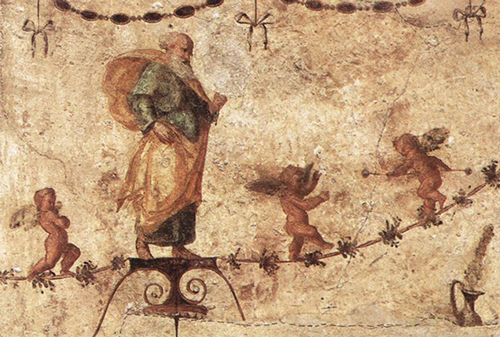
– LOGGETTA OF CARDINAL BIBBIENA
How would that feel? You would swing there in the damp and mouldy space, rope creaking and twisting above you, and you might enquire of yourself, like Alexander cresting the valley of the Indus—or, indeed, like me, in a grossly over-vegetated corner of Kelley’s garden, ankle-deep in a virgin trench, leaning on my spade—how can I best comprehend, or encompass, or incorporate this vista unspooling before me? It was as though those painters had broken through to the repository of all Ideas (located, aptly, in a cave), the search for which had been guiding them for generations; and it was like nothing that they had, or could ever have, imagined.
Needless to say, they left graffiti. Who could resist? You can still read their names now, scratched into the plaster – Karel van Mander, Pierino Fiorentino, Giovanni da Udine. In the same way, Alexander the Great inscribed an empire on the rude map of the earth; and we have the stratified, scratchy beginnings of our little Anatomy.
These spoils of the past, after all, are now recovered to our present. And we in turn, like our stories and at our best, are unanchored, filaments of loose and associative organisation in an all encompassing, unstratified, universal present. So when Raphael, for example, clambered out of the domus aurea (perhaps dragging his pupils, Pierino Fiorentino and Giovanni da Udine by the ears behind him), he was already translating whatever it was he thought he had seen into a fresh decorative array, one which would, in due course, find its way on to the walls of the Loggetta of Cardinal Bibbiena. A space we can now, if it please us, have ourselves lowered into, to marvel at, learn from, translate afresh, and recover for ourselves.
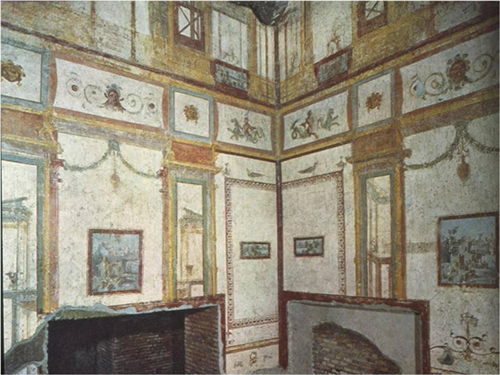
– DOMUS AUREA, ROOM 78
As Hunter Sidney suggests, if our stories are apt to become curiosities which we turn over half-bored, unremembering, from time to time, then alternatives might exist: our present might be traversed as a field of knowable stones, of temporally dislodged exotica, which we study at leisure, muse over, or on a whim, graffiti, purloin and repurpose.
Anatomy of Norbiton on HILOBROW
Original post at Anatomy of Norbiton: Archaeological
Anatomy of Norbiton
Short Life in a Strange World by Toby Ferris
Toby Ferris on Twitter
On the Paintings of Pieter Bruegel by Toby Ferris
All tapir illustrations by Anna Keen: portfolio

